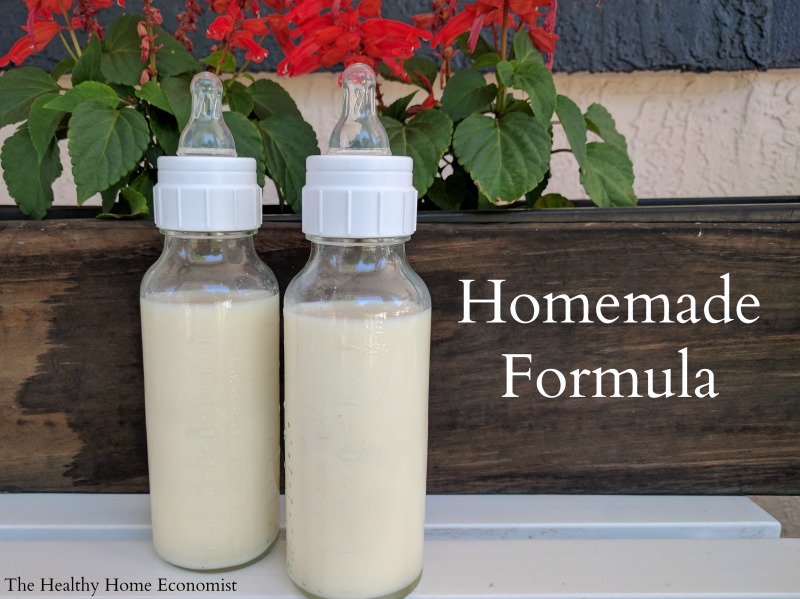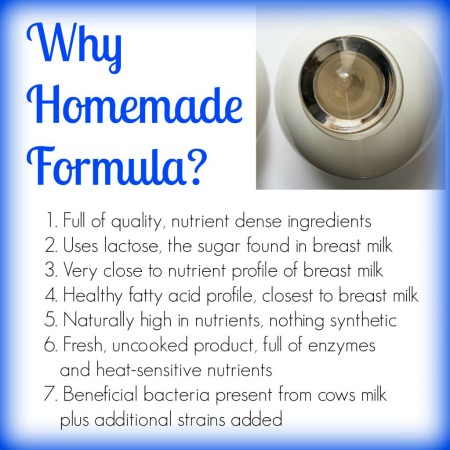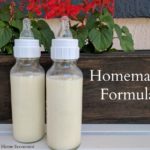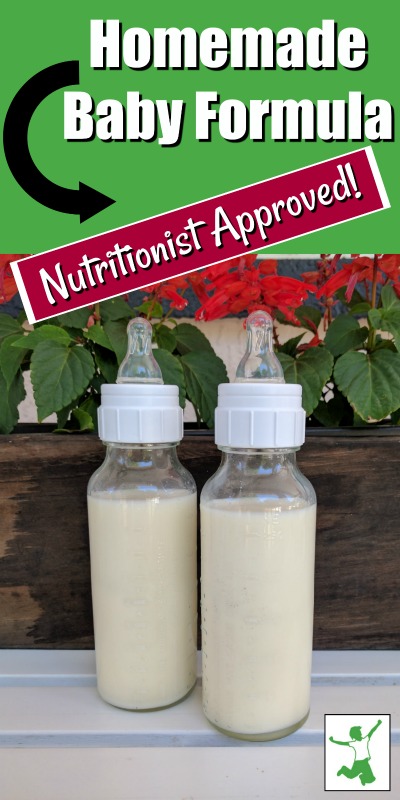Table of Contents[Hide][Show]
A nourishing homemade baby formula using safe, whole ingredients. This recipe was developed and tested by Dr. Mary Enig, a PhD Nutritionist and originally published in Nourishing Traditions cookbook in 1996. It was formulated to match breastmilk as closely as possible and is also suitable for infants. Source: Weston A. Price Foundation

There is no doubt that breastfeeding your baby is the best option for the child’s long-term health and development. Human breastmilk from a well-nourished mother is the perfect food for baby. However, in circumstances where the child is adopted or the Mother finds herself unable to breastfeed, formula feeding becomes necessary. In those cases, homemade baby formula is best.
Using a baby formula recipe that closely matches the nutritional profile of breastmilk is a far better choice than even organic baby formula from the health food store. More on this below.
Note: Donor programs are widely available for human breastmilk. But, the diets of the donor mothers are unknown and most likely nutritionally insufficient. In addition, breastmilk banks pasteurize the donated breastmilk which destroys much of the nutritional benefit. Unless you are fortunate to have a trusted and direct donor milk source in your community, avoid this option!
Dangers of Commercial Formula
Commercial formulas are always a poor choice for a number of reasons. First of all, formula manufacturers line the cans with the chemical BPA. This substance disrupts hormone development and is a probable contributor to early puberty in girls, and ADHD, urogenital abnormalities, and other ills in boys.
The European Food Safety Authority found that canned commercial formula is a significant source of BPA for infants, exposing the child to 13mcg of BPA per kg of body weight per day! BPA-free formula cans are no better. The chemical BPS is typically used instead which is just as dangerous.
Beware that manufacturers pack even organic commercial formula like Earth’s Best in BPA cans. Worse, they use organic brown rice syrup as the primary sweetener which is known to be frequently contaminated with arsenic.
In addition, all commercial milk formulas are processed at extremely high temperatures which violently denature the fragile milk proteins, render them allergenic, and add carcinogens to the final product. Soy infant formula is the worst. Obscenely high processing temperatures not only denature the proteins but large levels of phytic acid in soy block mineral absorption by the infant. Moreover, soy-based plant estrogens disrupt the hormonal development of the baby!
It seems that for the concerned Mother who is unable to breastfeed, learning how to make baby formula at home with safe, pure ingredients is the most prudent way to go!
Why Make Homemade Formula Even if You Are Breastfeeding
In the video below, I show you how to make your own safe, healthy raw milk homemade formula for your baby.
The recipe I follow was originally published in the cookbook Nourishing Traditions in 1996 and developed by Dr. Mary Enig.
Even though I breastfed each of my children for at least 2 years, I made this exact formula for my own children when I was away for the day or the evening as pumping was not an option that worked well for me.
I even used this homemade formula for an entire day once when I had some dental work done and was advised to pump and discard for 24 hours.
As a result, even successfully breastfeeding Moms can use this wonderful homemade formula as a supplement when necessary to their own nutrient-dense breastmilk!
It is advised that even breastfeeding Mothers have the ingredients for this formula on hand for an emergency. If Mom is sick or otherwise unable to nurse, Dad can step in and make this safe alternative until Mom is back on her feet. It takes a few days to a week to gather all the ingredients together to make this formula, which is why I advise having them on hand at all times.
Homemade Most Nutritious
The image below lists the reasons why it is worth it nutritionally to make formula yourself for your precious baby!
You can order all of the required ingredients for the homemade baby formula in one package from this reputable, vetted source.
Moms who have successfully used this formula feeding your children, please post about your experience in the comments section to encourage those who are considering it and need some Mom to Mom encouragement!

Where to Source Quality Milk
The most widely available grass-fed milk around the world is from cows. This is usually the most budget-friendly and easily sourced milk for this recipe for homemade formula.
If only goat milk is available in your area, this recipe for goat milk baby formula can be used instead. When using milk from ewes, please refer to the linked article for an adjusted recipe; one of the benefits of sheep milk is that it is higher in healthy fats than either goat or cow milk.
Camel milk formula is another option that is a particularly digestible form of dairy and growing in popularity around the world.
Alternatively, you can use low temp (vat) pasteurized, non-homogenized whole milk cultured with a piima or kefir starter. Then substitute the piima milk or kefir for the raw milk portion of the formula recipe. Cold-pressed raw milk also must be cultured before using it as it contains no probiotics.
Do NOT use ultrapasteurized (UHT) milk even if organic as it is too highly processed and extremely allergenic!
It is also best to avoid all types of powdered milk for this recipe. The factory process of making milk powder reduces nutrition considerably and denatures it, which makes it more likely baby will have an allergic reaction.
Dairy Allergy Option
If all types of dairy prove unsuitable for your baby, make this nondairy baby formula recipe instead. It uses a base of homemade bone broth as a substitute for milk. It is important not to utilize a plant-based or otherwise vegan baby formula recipe.
Avoid buying bone broth to make the dairy-free formula. Make it yourself! Manufacturers of commercial bone broth, even if authentic, may water down the end product. This is apparent if it does not gel when chilled in the refrigerator.
Many brands have toxic packaging issues as well. If you must buy it in a pinch, see my shopping guide page for vetted brands that are safe.

Homemade Baby Formula Recipe (for infants too)
A nourishing baby formula recipe you can make at home with safe, whole ingredients developed and tested by a PhD nutritionist to match breastmilk as closely as possible. Also suitable for infants.
Ingredients
- 2 cups raw cow milk OR organic whole milk yogurt
- 1 7/8 cups filtered water
- 1/4 cup liquid whey
- 4 Tbl lactose
- 1/4 tsp Bifidobacterium infantis powder
- 2-4 Tbl raw or pasteurized cream
- 1/2 tsp cod liver oil unflavored
- 1/4 tsp butter oil unflavored
- 1 tsp sunflower oil preferably organic
- 1 tsp extra virgin olive oil preferably organic
- 2 tsp virgin coconut oil preferably organic
- 2 tsp nutritional yeast
- 2 tsp gelatin
- 1/4 tsp acerola powder
Instructions
-
Fill a 2 cup Pyrex measuring cup with filtered water and remove 2 TBL (this will give you 1 7/8 cup water).
-
Pour about half the water into a pan and turn burner on medium.
-
Add the gelatin and lactose and let dissolve, stirring occasionally.
-
When gelatin and lactose are dissolved, remove pan from heat and add the rest of the water to cool.
-
Stir in the coconut oil and butter oil until melted.
-
Put remaining ingredients in a glass blender.
-
Add the water mixture and blend for about 3 seconds.
-
Place formula in glass baby bottles or a glass jar and refrigerate.
-
Before giving to baby, warm glass bottle in a pan of hot water or a bottle warmer. NEVER microwave baby bottles!
Recipe Video
Recipe Notes
If using raw cow milk from holstein cows, use 4 Tbl of extra cream (otherwise use 2 Tbl extra cream).
If choosing to make this homemade formula with camel milk, be sure to include 4 Tbl extra cream as camel milk is lower in cream than cow milk.
Do not use high oleic sunflower oil. Use only the brand recommended in the ingredients list which is cold pressed, organic, unrefined, and low oleic.
*Do NOT use powdered whey from the store as it is denatured. Avoid whey from making cheese as it will curdle the formula.
*Do not substitute pasteurized or powdered milk as these are heavily processed, denatured and allergenic foods.
*Do NOT use ultrapasteurized (UHT) cream. It is highly allergenic. Raw or pasteurized cream is acceptable.
*Do NOT use fish oil or krill oil instead of high vitamin cod liver oil as they do not contain any Vitamin D and very little to no Vitamin A.
Collagen powder may be substituted for the gelatin in a pinch (more on peptides in baby formula in this article).
If you are wondering where is the iron in homemade baby formula, this article provides an explanation.
If baby experiences constipation using this formula, try adding 1 tsp of molasses to each batch. This should help move things along.
How to Transition to DIY Formula
Once you’ve viewed the video, gathered the ingredients, and made your first batch, how do you feed it to your baby for the first time?
It is important not to switch all at once as this can cause gas, excessive spit-up, or an uncomfortable change in diaper habits such as constipation or overly loose stools.
Start by giving your baby three-quarters of the old formula blended with one-quarter of the homemade. Try this ratio for a day or two and see how your infant responds.
If no digestive upset or major change in diaper habits occurs, increase the amount to a 50-50 blend of old formula to homemade. Observe for another day or two as before.
If no major issues, increase once again to three-quarters homemade formula to one-quarter old formula. If baby does well on this blend for a third time, you are ready to fully transition to the homemade formula.
At any time during the transition, symptoms of intolerance emerge, back up to the previous successful blend ratio and stay there for a day or two before attempting to increase once again.
Homemade Formula FAQ
Weston Price Foundation
Feeding an Adopted Baby
Traveling Tips with Baby Formula Made at Home
Iron in Baby Formula
Collagen Peptides instead of Gelatin for Homemade Formula?










Sarah, I can’t thank you enough for posting about this. I recently had a baby and it was discovered after he was born that we had a situation of velamentous cord insertion causing him to be underweight at birth. I took him to the doctor to have him get weight checks and after a few times of him not gaining what the doctors thought was adequate, they strongly recommended that I supplement breastfeeding with formula. Obviously, they were recommending I use commercial formula, and that thought terrified me because I strongly feared that by trying to make my baby healthier by feeding him formula, I was, in essence, putting him at risk for future illnesses and unnecessary chemical exposure. So, thankfully for your post and video, as well as some invaluable information I read from the Weston A. Price Foundation, I am able to feed my baby a safe and healthy formula that I can feel good about giving him. I have noticed that he has become more alert and has had increased bowel movements in the days since starting the homemade formula supplementation. I so appreciate the work you all do so that we are better informed and can make safer and healthier choices for our families.
It doesn’t look like Sarah responds to questions any longer, but I am desperately wondering if someone else might be able to help me out. How do you culture pasteurized organic whole milk back to life for the homeade formula? Am I basically making kefir then, or do you just add a starter before you do the mixing? Raw milk is illegal in Montana. I have not been able to find any information on this. Please and thank you!!
Hi Alicia,
You simply culture it for 12 hours with kefir starter grains. So not as long as it would take to actually make kefir.
Hope that helps.
Claudia
That is helpful, Claudia, thank you so much. The starter instructions said 18 – 24 hours for milk kefir, but I don’t want the formula to taste sour!! I will try 12 hours. Thanks again!
What’s the measurements to make 1 bottle ???
Stephanie,
One “batch” makes 6-6oz bottles or 36 oz, so depending on how big the bottles are, yhou would have to adjust accordingly. I just made a half batch because that was all the raw milk ( 1 cup) we had left. It would make 18 oz and honestly would be a lot easier just do half the batch than to try and figure out how to just to 1- 6oz bottle. The measurements need to be EXACT to get the proper balance and it would be really hard when one is doing 1/6th of a recipe.
Hi there , I was wonderin if a baby was sensitive to dairy can be on homemade baby formula??
Hi, I am going to start making this formula for my daughter and have all the ingredients. I am confused on what type of cream it calls for? And where to get it. Thanks!
A little late but I buy cream from the same place I buy the raw milk, I do know many farmers don’t sell cream, but another option is to buy extra milk, place it in a mason jar, and carefully scoop out the cream from the top.
Hello i need to purchase the ingredients for this homemade formula, but for some reason the link you gave is not properly working? Could you please send me the correct link?
Sarah
i just made this and mines a little lumpy, little white clumps, it keeps clogging bottle. What did i do wrong?
Probably nothing… unless I have been doing something wrong the last 4 months. Mine is like that too! But it doesn’t clog the bottle. If you want another place to ask questions here is a link to a Yahoo! group I am in and you will get lots of helpful answers.
Hello Everyone, I have been giving my son this homemade formula since he was 4 months old substituting one bottle a day and breastfeeding because my supply was low. When he turned 6 months he weaned himself off breasf feeding and I have been giving him the formula ever since. He has never had any stomach issues and he is growing so strong and has not been sick. I have a question for those of you who make this full time…How long do you think I need to feed my son the formula? He will be a year in 2 weeks, and I am wondering if straight raw milk is fine? Any insight would be great, but for now, I will continue making this liquid gold 🙂
my child is younger than yours so I am not there yet but I think it would be good to introduce raw whole cows milk along with the formula, like you did when you started using the formula slowly along with breastmilk. That being said, when I make the formula for baby, my toddler always wants some and I give it to her. I really think you can use this as milk for a long time, but you could start giving plain milk too just to make it easier on yourself along with it.
Thank you Rebecca. You have been great answering everyone’s questions. My son has been drinking straight raw cow’s milk since 2 weeks after his first b-day. He likes it and I still give him as a supplement, cod liver oil mix with fresh orange juice, and daily dose of coconut oil. He is doing well on it. This formula has been a life saver, since in the end you spend less money, and its much more nutritious than store bought formula.
Hi sarah,
I’ve just found your blog and am def going to be making this formula (if needed) for my baby, I am expecting, however I wish I would have know these things and researched for my son who is now 5. I gave him canned infant formula and feel horrible about it!! So many moms aren’t even aware…. Do you have any suggestions as far as vitamins/ nutrients/ supplements for my 5 yr. old? Thanks 🙂